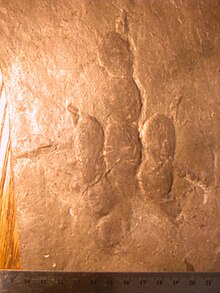Grallator
| Grallator | |
|---|---|
 |
|
| Trace fossil classification | |
| Ichnoclass: | Reptilipedia |
| Ichnocohort: | Theropodipedia |
| Ichnofamily: | †Grallatoridae |
| Ichnogenus: |
†Grallator Hitchcock, 1858 |
| Type ichnospecies | |
|
G. cursorius Hitchcock, 1858 |
|
| Ichnospecies | |
| Synonyms | |
Grallator is an ichnogenus (form taxon based on footprints) which covers a common type of small, three-toed print made by a variety of bipedal theropod dinosaurs. Grallator-type footprints have been found in formations dating from the late Triassic through to the early Cretaceous periods. They are found in the United States, Canada, Europe, Australia and China but are most abundant on the east coast of North America, especially the Triassic and Early Jurassic formations of the northern part of the Newark Supergroup. The name Grallator translates into "stilt walker", although the actual length and form of the trackmaking legs varied by species, usually unidentified. The related term "Grallae" is an ancient name for the presumed group of long-legged wading birds, such as storks and herons. These footprints were given this name by their discoverer, Edward Hitchcock, in 1858.
Grallator footprints are characteristically three-toed (tridactyl) and range from 5 to 15 centimeters (or 2 to 6 inches) long. Though the tracks show only three toes, the trackmakers likely had between four and five toes on their feet. While it is usually impossible to match these prints with the exact dinosaur species that left them, it is sometimes possible to narrow down potential trackmakers by comparing the proportions in individual Grallator ichnospecies with known dinosaurs of the same formation. For example, Grallator tracks identified from the Yixian Formation may have been left by Caudipteryx.
The most famous, and archetypal tracks that conform to the Grallator type are those found on the East Coast of North America, specifically from the Late Triassic to Early Jurassic Newark Supergroup. These footprints were likely made by an unidentified, primitive dinosaur similar to Coelophysis. The Newark Supergroup footprints show digits II, III and IV, but no trace of the shorter digits I and V which would likely have been present in a dinosaur of this stage. The outer two digits would have been stubby and ineffective, not touching the ground during walking or running. Despite losing most of their effectiveness, dinosaur evolution had not yet removed these digits to fully streamline the foot. This is known because rare specimens are found with traces of these outer digits. Digits II, III and IV have 3, 4 and 5 phalanges respectively, giving Grallator a ?-3-4-5-? digital formula.
...
Wikipedia
